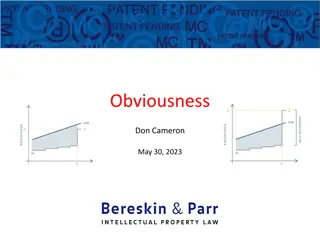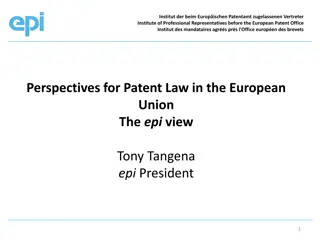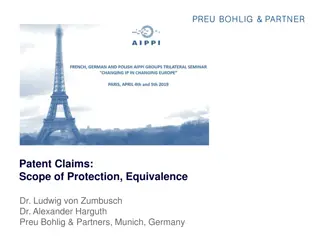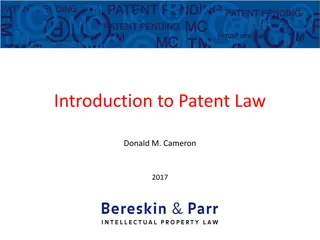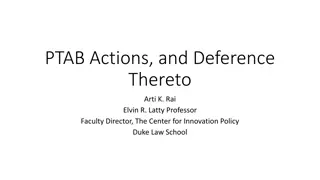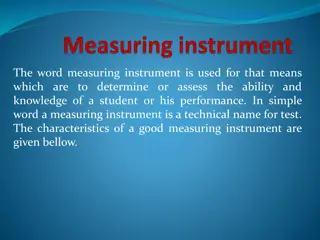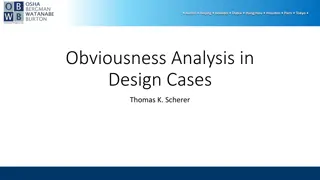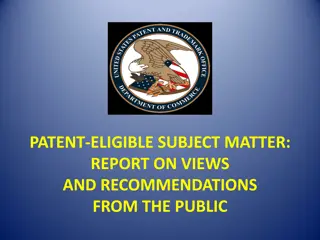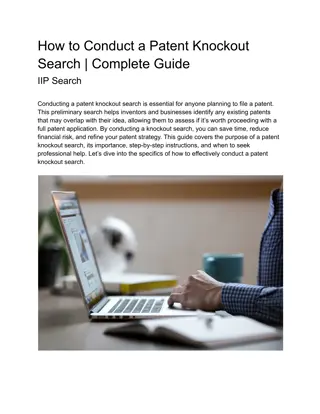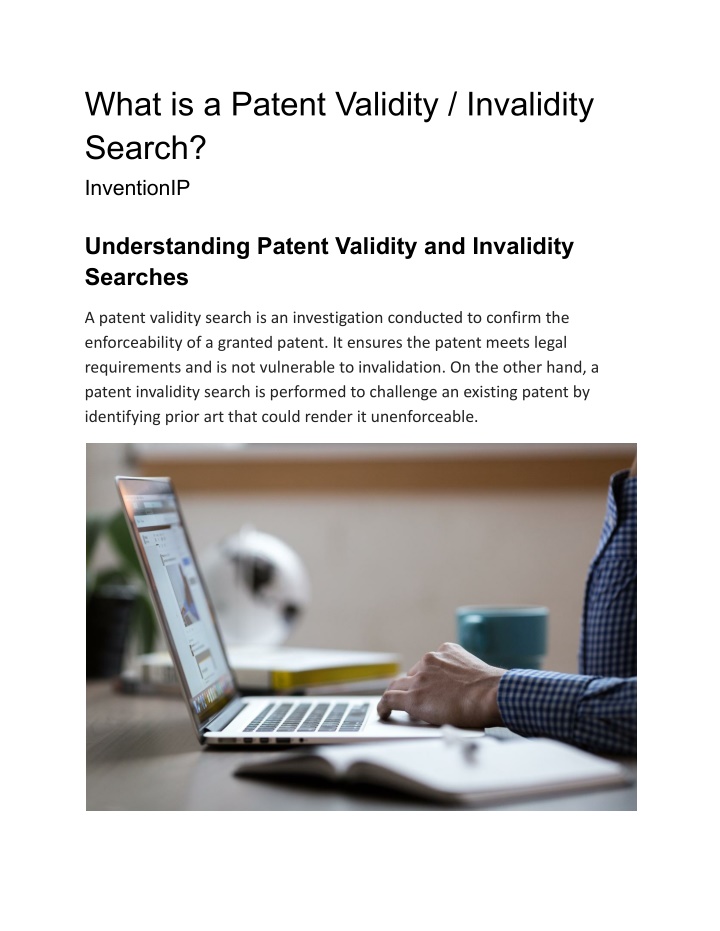
What is a Patent Validity / Invalidity Search? | Complete Guide | InventionIP
A patent validity or invalidity search is essential for assessing the strength of a granted patent or challenging its enforceability. This blog explores why businesses conduct these searches, their key components, and how they help in patent litigati
Uploaded on | 0 Views
Download Presentation

Please find below an Image/Link to download the presentation.
The content on the website is provided AS IS for your information and personal use only. It may not be sold, licensed, or shared on other websites without obtaining consent from the author. If you encounter any issues during the download, it is possible that the publisher has removed the file from their server.
You are allowed to download the files provided on this website for personal or commercial use, subject to the condition that they are used lawfully. All files are the property of their respective owners.
The content on the website is provided AS IS for your information and personal use only. It may not be sold, licensed, or shared on other websites without obtaining consent from the author.
E N D
Presentation Transcript
What is a Patent Validity / Invalidity Search? InventionIP Understanding Patent Validity and Invalidity Searches A patent validity search is an investigation conducted to confirm the enforceability of a granted patent. It ensures the patent meets legal requirements and is not vulnerable to invalidation. On the other hand, a patent invalidity search is performed to challenge an existing patent by identifying prior art that could render it unenforceable.
Why Conduct a Patent Validity Search? Businesses and legal professionals conduct validity searches to assess the strength of a patent before litigation or licensing. This process helps investors and companies avoid potential legal disputes by verifying that a patent holds up against prior art. A validity search is particularly useful in the following scenarios: Patent Licensing and Transactions Companies looking to license or acquire patents conduct validity searches to ensure they are investing in a strong patent. Patent Enforcement Before enforcing a patent against infringers, businesses validate its strength to avoid unnecessary legal battles. Due Diligence Investors and stakeholders verify the legal status of patents before funding new technologies. Reasons for a Patent Invalidity Search A patent invalidity search is often performed when a company or individual faces patent infringement claims. Finding prior art that predates the patent s filing date can lead to invalidation, helping the accused party defend against lawsuits. Additional reasons include: Defense Against Patent Litigation If sued for infringement, an invalidity search can help prove the patent should never have been granted. Freedom to Operate (FTO) Analysis Businesses aiming to launch new products may conduct invalidity searches to challenge blocking patents. Competitor Analysis Companies analyze competitors patents to find weaknesses and identify opportunities to invalidate them.
Key Elements of a Patent Validity Search A thorough patent validity search involves multiple components to ensure its reliability. Some key elements include: Prior Art Examination Identifies previously published works or patents similar to the one in question. Legal Framework Compliance Ensures the patent follows national and international patent laws. Patent Claim Analysis Evaluates the scope and enforceability of the claims within the patent. Patent Examination History Review Analyzes how the patent was granted and whether there were rejections or amendments during prosecution. Patent Citations and References Investigates references cited by the patent examiner or cited by other patents to assess its novelty. Key Elements of a Patent Invalidity Search A patent invalidity search aims to uncover prior art that can render a patent unenforceable. The primary factors include: Prior Art Discovery Finding earlier patents or literature that may challenge the patent s originality. Comparison with Existing Patents Determines whether the patent overlaps with prior inventions. Legal Analysis Assesses whether the patent meets all legal requirements. Technical Literature Search Reviews industry publications, research papers, and manuals that may disclose similar technology.
Foreign Patents and Non-Patent Literature Searches global databases for patents and other documents that could serve as prior art. How to Conduct a Patent Validity or Invalidity Search Conducting a patent validity or invalidity search requires a systematic approach to ensure comprehensive results. Here are the essential steps: 1.Define the Scope Determine the jurisdiction, technical field, and focus of the search. 2.Use Patent Databases Search in global databases like USPTO, EPO, WIPO, Google Patents, and commercial databases. 3.Analyze Prior Art Identify similarities with earlier patents and publications. 4.Consult Experts Patent attorneys or professionals help interpret findings. 5.Prepare a Report Document evidence supporting validity or invalidity claims with proper citations. 6.Review Litigation History Check if the patent has been previously challenged in court. 7.Utilize AI and Automation Tools Leverage advanced search tools that can improve efficiency in finding relevant prior art.
Common Challenges in Patent Validity and Invalidity Searches While patent searches provide valuable insights, they come with challenges, such as: Limited Access to Unpublished Prior Art Some prior inventions may not be publicly documented. Complexity of Legal Interpretations Legal standards for validity vary across jurisdictions. Time-Consuming Research Comprehensive searches require extensive database exploration. Translation Issues Prior art may be in foreign languages, making interpretation challenging. Constantly Evolving Technology Innovations evolve rapidly, and new prior art may emerge after patent grants. Importance of Patent Searches for Businesses A well-conducted patent validity search protects businesses from licensing invalid patents. An invalidity search helps defend against infringement claims and avoid costly lawsuits. Both processes contribute to informed decision-making in intellectual property matters. Benefits of Patent Validity Searches for Businesses Risk Mitigation Reduces the risk of investing in weak or legally vulnerable patents.
Stronger Patent Portfolio Ensures that owned patents are defensible and enforceable. Enhanced Negotiation Power Strengthens licensing and investment discussions with verified patents. Benefits of Patent Invalidity Searches for Businesses Freedom to Operate Clears legal barriers before launching new products. Legal Cost Reduction Prevents unnecessary litigation expenses. Competitive Edge Helps challenge competitors patents strategically. How to Choose a Reliable Patent Search Provider Given the complexity of patent searches, partnering with a professional service provider ensures accuracy. Consider the following factors when selecting a provider: Experience in Intellectual Property Law Ensure the firm has expertise in patent law and prior art research. Access to Comprehensive Databases The provider should have access to global patent and non-patent literature databases. Strong Analytical Skills The team should have the ability to interpret prior art and legal implications effectively.
Confidentiality Assurance Patent searches involve sensitive information, so choose a provider with strong confidentiality policies. Conclusion A patent validity or invalidity search is essential for patent holders and businesses navigating intellectual property disputes. Conducting thorough research ensures that patents remain enforceable or can be legally challenged if necessary. Proper analysis protects investments and prevents legal conflicts in competitive industries. To get professional assistance with patent validity or invalidity searches, visit InventionIP Patent Invalidity/Validity Search today.




